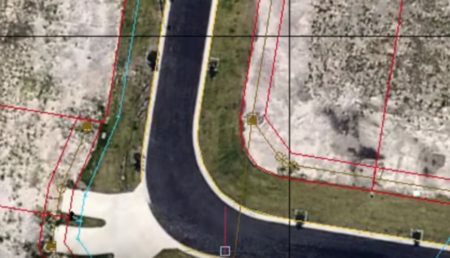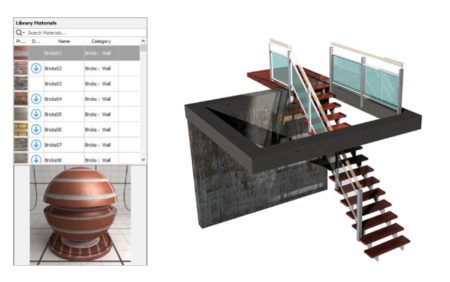BricsCAD is a software application for computer-aided design (CAD), developed by Bricsys, headquartered in Ghent, Belgium and has additional development centers in Russia and Romania.
What is new in BricsCAD V16?
Transparency—the new transparency effect can be used to improve the look of drawings by applying it to solid fills and other objects. BricsCAD lets you set the level of transparency and apply the property directly to objects with the ability to assign transparency through layers.
Dynamic arrays—Arrays are associative and dynamic. Create rectangular, polar, linear, path and 3D arrays dynamically. Associativity means that you edit one object and then apply the changes to all other objects in the array.
Multi-Column Text and Stacked text—The “MText” command lets users create two or more columns of text with the new column option changing the width and height of columns…is as easy as dragging grips.

01 – The Web Map Services and Geographic locations function remembers the ten most recent connections for subsequent sessions.
Web Map Services and Geographic locations improvement—The Map Connect function places maps from Web-based map services into drawings. One or more data layers can be selected for download, which are then inserted in drawings as images.
New in 3D Modeling
Surface Entity Creation—Create surface entities from scratch and edit imported surfaces using direct modeling and 3D constraints, just like with 3D solid bodies. You can add and remove openings to and from surfaces, as well as thicken surfaces into 3D solids.
Lofting—Use BricsCAD’s new Loft command to create 3D solids by specifying cross section profiles. The cross sections define the shape of the solid.
Deformable Modeling—Make complex geometric objects and artistic shapes by deforming 3D solids and surfaces by moving, rotating, and replacing their vertices, edges, and any other point along their edges and faces.
Generated drawing views—The Generated Drawing View feature is completely reworked. After it creates correctly projected views of 3D models, you can change their scales and toggle the visibility of hidden lines. In addition, you can specify the design of sections views, section lines, detail views and detail symbols.
Geometry healing—When importing 3D models, BricsCAD automatically heals geometry, as necessary. In addition, you can repair and simplify imported models, as well as stitch disjointed surfaces.
Support for Photometric Lighting—Rendering of 3D models is improved by using IES files with Web lights. This lets BricsCAD accurately depict the exact distribution of illumination, according to manufacturer specifications.
Assembly Design—Working with components is much more flexible as BricsCAD provides the following addition operations:
- Open a copy of a component as a new document
- Replace components
- Switch between eccentric and local components
- Convert native blocks to local components
- Covert referenced drawings (refs) to external components
Enchanced BIM functions
Windows and doors—BricsCAD BIM includes a library of 20 types of windows and doors. To specify windows and doors, choose or modify a design from the library, or else create your own designs from scratch. You can insert, mirror, and reposition windows using dynamic dimensions, and then insert additional ones with the same definitions and parameters, or else use the Properties panel to change the windows’ definitions.
BIM panel—The same flexibility BricsCAD offers in 3D modeling, it also offers in attaching information to building elements. All BIM database features are accessible through the dockable BIM panel.
BIM Project Database—BricsCAD stores building materials and compositions in its project database:
- Building materials contain information about a specific material, along with a layer name and a rendering definition
- Compositions contain information about the structure of building elements as defined by one or more layers
Tags can be attached to each building material or composition, and then used to filter the BIM database. Any number of custom properties can be added to building material and composition definitions.
Library Database—The library database included with BricsCAD allows you to reuse compositions and building materials across multiple BIM projects. To share information among databases, simply drag building materials and compositions from one database to another.
Drawing Generation—The redesigned drawing generation feature lets you generate sheet sets in seconds. The dockable Sheet Set manager offers smooth navigation between the project drawings.
Availability
BricsCAD version 16 is available on both Windows, Linux and Mac OS X. It comes in three versions from Classic, Pro to Platinum, with upgrades starting at 235.USD and new licenses at 520.USD. The Pro version adds the full 3D features and BIM tools but not the 3D constraints solving and assembly builder only available in Platinum, with prices starting at 990.USD.
To learn more visit them here: http://www.bricsys.com





Reader Comments
Multiplatform BricsCAD version 16 now available |via @architosh https://t.co/KALDGcxCsQ
Multiplatform BricsCAD version 16 now available |via @architosh https://t.co/KALDGcxCsQ
RT @appleforarch: Multiplatform BricsCAD version 16 now available |via @architosh https://t.co/KALDGcxCsQ
RT @appleforarch: Multiplatform BricsCAD version 16 now available |via @architosh https://t.co/KALDGcxCsQ
Comments are closed.